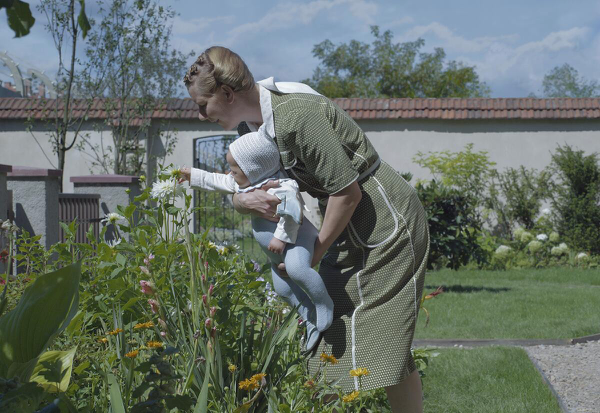Movie review by Greg Carlson
Loosely based on the 2014 novel by Martin Amis, Jonathan Glazer’s adaptation of “The Zone of Interest” makes a perfect visual companion to the great political thinker Hannah Arendt’s most quoted concept. Introduced in her 1961 work for “The New Yorker” and then incorporated into the title of the 1963 book “Eichmann in Jerusalem: A Report on the Banality of Evil,” Arendt’s argument that the Nazi bureaucrat fulfilled his duties without any deliberate sadism – but rather, a kind of disengagement – continues to ignite debate (for a solid primer see Thomas White’s concise essay for “Aeon”). Glazer uses Rudolph Höss (Christian Friedel), the longest serving commandant of Auschwitz, to probe the kind of unremarkable and ordinary evil that threatens us again today.
Glazer, whose rigorous stylistic choices have frequently drawn favorable comparisons to Stanley Kubrick, spent years preparing the film, returning the fictionalized version of his central figure (as imagined by Amis) to the historical SS officer who would eventually hang in 1947 for his role as a mass murderer. Glazer sought the support of the Auschwitz-Birkenau State Museum, accessing archival material that aided in the construction of a screenplay emphasizing the daily domestic routines of the Höss household overseen by Rudolph’s wife Hedwig (a chillingly effective Sandra Hüller).
Living in a neatly-kept house adjacent to the concentration camp, Rudolph and Hedwig raise their five children with the help of servants and the support of exploited prisoners. Glazer stages a series of scenes in which the members of the Höss family enjoy the leisure and comforts of their station. Swimming, sunbathing, gardening, playing, fishing, and celebrating birthdays mark the passage of time. But any sense of comprehensive peace is shattered by the constant sounds of screams and gunshots coming from the other side of the wall that serves as a barrier between the Höss home and the machine-tooled workings of the death camp overseen by Rudolph.
“The Zone of Interest” sustains our sense of stricken fascination in part through Glazer’s use of hidden cameras placed throughout the set, a technique recalling the filmmaker’s memorable approach to capturing unrehearsed and unguarded moments of civilians whose curiosity brought them to the van piloted by Scarlett Johansson during “Under the Skin.” Other elements, including scenes of a girl presented in the otherworldly glow of monochromatic, night-vision negative (which may for some call to mind the child in the red coat in “Schindler’s List”), intensify the experience as surely as the brilliant Mica Levi score.
Late in the film, Glazer makes a Kubrickian cut spanning decades of time to a series of sobering shots that link past and present in a way that should unnerve anyone who has recently tolerated the extremism of the far-right and the rhetoric of politicians and candidates who espouse nationalism and authoritarianism. Glazer also includes a brief moment that rhymes with an eerily similar scene in “The Act of Killing” featuring another example of Arendt’s concept personified. Rudolph Höss, we notice, is an awful lot like the Indonesian death squad executioner Anwar Congo. We should all hope that we don’t resemble either man.
